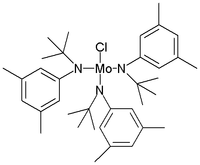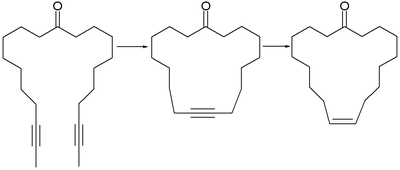
Alkyne metathesis
Encyclopedia
Alkyne metathesis is an organic reaction
involving the redistribution of alkyne
chemical bond
s. This reaction is closely related to olefin metathesis
. Metal-catalyzed alkyne metathesis was first described in 1968 by Bailey, et al. The Bailey system utilized a mixture of tungsten and silicon oxides at temperatures as high as 450 °C. In 1974 Montreux reported the use of a homogeneous catalyst—molybdenum hexacarbonyl at 160 °C—to observe an alkyne scrambling phenomenon, in which an unsymmetric alkyne equilibrates
with its two symmetrical derivative.
catalyst molybdenum hexacarbonyl
Mo(CO)6 and resorcinol
cocatalyst. In 1975 T.J. Katz proposed a metal carbyne and a metallacyclobutadiene as an intermediate and in 1981 R.R. Schrock
characterized several metallacyclobutadiene complexes that were catalytically active.
The Schrock catalyst system tris(t-butoxy)(2,2-dimethylpropylidyne)tungsten(VI) is unreactive towards alkenes. On the other hand Fischer carbenes have no value in alkyne or alkene metathesis.
The Schrock catalyst is commercially available and is prepared by amidation of tungsten tetrachloride with lithium dimethylamide to a W2(NMe2)6 which undergoes alcoholysis by tert-butoxy groups with tert-butanol
.
This alkylidyne complex undergoes a metathesis with neoheptyne to give the final product. In 2001, Fürstner reported a new molybdenum catalyst replacing alkoxide
with aniline
ligand
s.
can be synthesised from a di-alkyne. After ring closure the new triple bond is stereoselectively reduced with hydrogen
and the lindlar catalyst
in order to obtain the Z-alkene (cyclic E-alkenes are available through the Birch reduction
). An important driving force for this type of reaction is the expulsion of small gaseous molecules such as acetylene
or 2-butyne
.
The same two-step procedure was used in the synthesis of the naturally occurring cyclophane
turriane.
and introducing a nitrile
Nitrile-Alkyne Cross-Metathesis or NACM couples two nitrile groups together to a new alkyne. Nitrogen is collected by use of a sacrificial alkyne (elemental N2 is not formed):
Organic reaction
Organic reactions are chemical reactions involving organic compounds. The basic organic chemistry reaction types are addition reactions, elimination reactions, substitution reactions, pericyclic reactions, rearrangement reactions, photochemical reactions and redox reactions. In organic synthesis,...
involving the redistribution of alkyne
Alkyne
Alkynes are hydrocarbons that have a triple bond between two carbon atoms, with the formula CnH2n-2. Alkynes are traditionally known as acetylenes, although the name acetylene also refers specifically to C2H2, known formally as ethyne using IUPAC nomenclature...
chemical bond
Chemical bond
A chemical bond is an attraction between atoms that allows the formation of chemical substances that contain two or more atoms. The bond is caused by the electromagnetic force attraction between opposite charges, either between electrons and nuclei, or as the result of a dipole attraction...
s. This reaction is closely related to olefin metathesis
Olefin metathesis
Olefin metathesis or transalkylidenation is an organic reaction that entails redistribution of alkylene fragments by the scission of carbon - carbon double bonds in olefins . Its advantages include the creation of fewer sideproducts and hazardous wastes. Yves Chauvin, Robert H. Grubbs, and Richard R...
. Metal-catalyzed alkyne metathesis was first described in 1968 by Bailey, et al. The Bailey system utilized a mixture of tungsten and silicon oxides at temperatures as high as 450 °C. In 1974 Montreux reported the use of a homogeneous catalyst—molybdenum hexacarbonyl at 160 °C—to observe an alkyne scrambling phenomenon, in which an unsymmetric alkyne equilibrates
Desymmetrization
Desymmetrization in stereochemistry is the modification of a molecule that results in the loss of one or more symmetry elements. An important application involves the introduction of chirality. Formally, such conversion require the loss of an improper axis of rotation...
with its two symmetrical derivative.
History
The Mortreux system consists of the molybdenumMolybdenum
Molybdenum , is a Group 6 chemical element with the symbol Mo and atomic number 42. The name is from Neo-Latin Molybdaenum, from Ancient Greek , meaning lead, itself proposed as a loanword from Anatolian Luvian and Lydian languages, since its ores were confused with lead ores...
catalyst molybdenum hexacarbonyl
Molybdenum hexacarbonyl
Molybdenum hexacarbonyl is the chemical compound with the formula Mo6. This colorless solid, like its chromium and tungsten analogues, is noteworthy as a volatile, air-stable derivative of a metal in its zero oxidation state.-Structure and properties:Mo6 adopts an octahedral geometry consisting...
Mo(CO)6 and resorcinol
Resorcinol
Resorcinol is a dihydroxy benzene. It is the 1,3-isomer of benzenediol with the formula C6H42.-Nomenclature:Benzene-1,3-diol is the name recommended by the International Union of Pure and Applied Chemistry in its 1993 Recommendations for the Nomenclature of Organic Chemistry.-Production:It is...
cocatalyst. In 1975 T.J. Katz proposed a metal carbyne and a metallacyclobutadiene as an intermediate and in 1981 R.R. Schrock
Richard R. Schrock
Richard Royce Schrock is an American chemist and Nobel laureate recognized for his contributions to the metathesis reaction used in organic chemistry.-Biography:...
characterized several metallacyclobutadiene complexes that were catalytically active.
The Schrock catalyst system tris(t-butoxy)(2,2-dimethylpropylidyne)tungsten(VI) is unreactive towards alkenes. On the other hand Fischer carbenes have no value in alkyne or alkene metathesis.
The Schrock catalyst is commercially available and is prepared by amidation of tungsten tetrachloride with lithium dimethylamide to a W2(NMe2)6 which undergoes alcoholysis by tert-butoxy groups with tert-butanol
Tert-Butanol
tert-Butanol, or 2-methyl-2-propanol, is the simplest tertiary alcohol. It is one of the four isomers of butanol. tert-Butanol is a clear liquid with a camphor-like odor. It is very soluble in water and miscible with ethanol and diethyl ether...
.
This alkylidyne complex undergoes a metathesis with neoheptyne to give the final product. In 2001, Fürstner reported a new molybdenum catalyst replacing alkoxide
Alkoxide
An alkoxide is the conjugate base of an alcohol and therefore consists of an organic group bonded to a negatively charged oxygen atom. They can be written as RO−, where R is the organic substituent. Alkoxides are strong bases and, when R is not bulky, good nucleophiles and good ligands...
with aniline
Aniline
Aniline, phenylamine or aminobenzene is an organic compound with the formula C6H5NH2. Consisting of a phenyl group attached to an amino group, aniline is the prototypical aromatic amine. Being a precursor to many industrial chemicals, its main use is in the manufacture of precursors to polyurethane...
ligand
Ligand
In coordination chemistry, a ligand is an ion or molecule that binds to a central metal atom to form a coordination complex. The bonding between metal and ligand generally involves formal donation of one or more of the ligand's electron pairs. The nature of metal-ligand bonding can range from...
s.
Ring closing alkyne metathesis
Alkyne metathesis is extensively used in ring-closing operations and RCAM stands for ring closing alkyne metathesis. The olfactory molecule civetoneCivetone
Civetone is a cyclic ketone and one of the oldest perfume ingredients known. It is a pheromone sourced from the African Civet. It has a strong musky odor that becomes pleasant at extreme dilutions. Civetone is closely related to muscone, the principal odiferous compound found in musk, because both...
can be synthesised from a di-alkyne. After ring closure the new triple bond is stereoselectively reduced with hydrogen
Hydrogen
Hydrogen is the chemical element with atomic number 1. It is represented by the symbol H. With an average atomic weight of , hydrogen is the lightest and most abundant chemical element, constituting roughly 75% of the Universe's chemical elemental mass. Stars in the main sequence are mainly...
and the lindlar catalyst
Lindlar catalyst
A Lindlar catalyst is a heterogeneous catalyst that consists of palladium deposited on calcium carbonate and treated with various forms of lead. The lead additive serves to deactivate the palladium sites. A variety of "catalyst poisons" have been used including lead acetate and lead oxide. The...
in order to obtain the Z-alkene (cyclic E-alkenes are available through the Birch reduction
Birch reduction
The Birch Reduction is an organic reaction which is particularly useful in synthetic organic chemistry. The reaction was reported in 1944 by the Australian chemist Arthur Birch working in the Dyson Perrins Laboratory in the University of Oxford, building on earlier work by Wooster and Godfrey in...
). An important driving force for this type of reaction is the expulsion of small gaseous molecules such as acetylene
Acetylene
Acetylene is the chemical compound with the formula C2H2. It is a hydrocarbon and the simplest alkyne. This colorless gas is widely used as a fuel and a chemical building block. It is unstable in pure form and thus is usually handled as a solution.As an alkyne, acetylene is unsaturated because...
or 2-butyne
Alkyne
Alkynes are hydrocarbons that have a triple bond between two carbon atoms, with the formula CnH2n-2. Alkynes are traditionally known as acetylenes, although the name acetylene also refers specifically to C2H2, known formally as ethyne using IUPAC nomenclature...
.
The same two-step procedure was used in the synthesis of the naturally occurring cyclophane
Cyclophane
A cyclophane is a hydrocarbon consisting of an aromatic unit and an aliphatic chain that forms a bridge between two non-adjacent positions of the aromatic ring. More complex derivatives with multiple aromatic units and bridges forming cagelike structures are also known...
turriane.
Nitrile-alkyne cross-metathesis
By replacing a tungsten alkylidyne by a tungsten nitrideTungsten nitride
Tungsten nitride is an inorganic compound, a nitride of tungsten. It is a hard, solid, brown-colored ceramic material that is electrically conductive and decomposes in water....
and introducing a nitrile
Nitrile
A nitrile is any organic compound that has a -C≡N functional group. The prefix cyano- is used interchangeably with the term nitrile in industrial literature. Nitriles are found in many useful compounds, one example being super glue .Inorganic compounds containing the -C≡N group are not called...
Nitrile-Alkyne Cross-Metathesis or NACM couples two nitrile groups together to a new alkyne. Nitrogen is collected by use of a sacrificial alkyne (elemental N2 is not formed):








